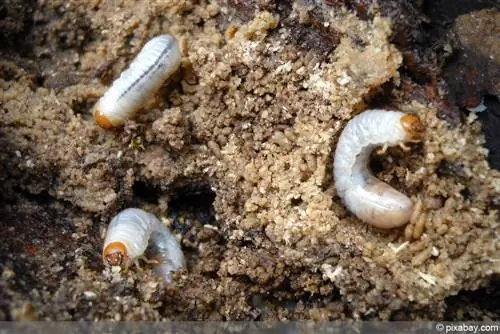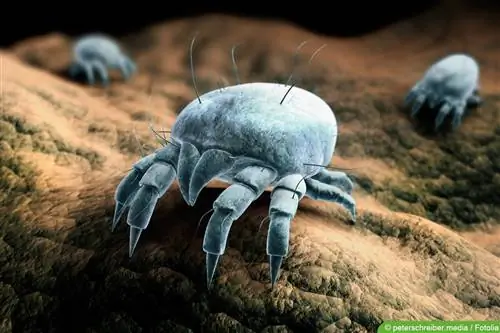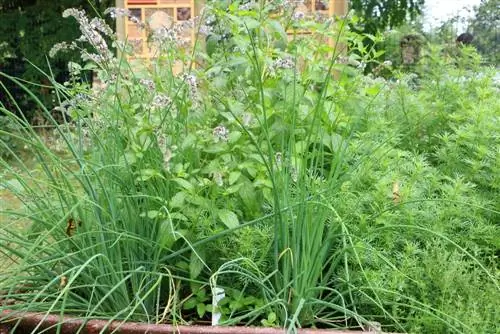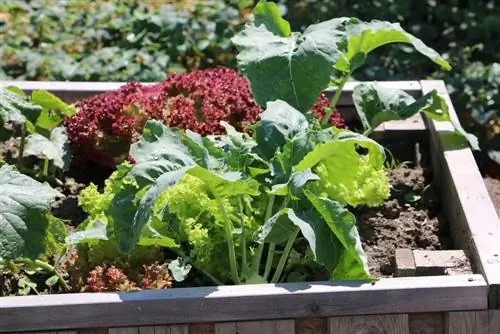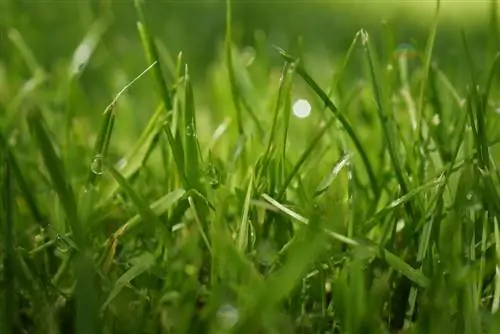- Author admin [email protected].
- Public 2024-02-02 01:49.
- Last modified 2025-01-24 12:45.
Nature lovers are happy when they encounter the shiny rose chafers, May and June beetles or the impressive rhinoceros beetles while walking in the forest. Before the beetles move to the deciduous trees, they live in the ground as grubs. The beetle larvae can cause a lot of damage in the garden because they prefer to feed on roots. What helps against an infestation? We will introduce you to effective methods.
The grub
The larvae of various scarab beetles (Scarabaeoidea) are called grubs. In our gardens it is mainly the larvae of the
- Cockchafer
- June beetle
- Rhino Beetle
- rose beetle
- Garden leaf beetle
coming.
Pest or beneficial insect?
It is important to know that not all grub species are harmful. Some of the beetle larvae are even useful helpers in the garden. Check what type of larvae it is before fighting it.
Rhinoceros beetle grub
The rhinoceros beetle (Oryctes nasicornis) is a protected species. It is the largest scarab beetle that occurs in Germany. The beetle gets its name from the backwards curved horn on the male's head. The beetle grows up to four centimeters long.
Characteristics of the larvae
- three long pairs of legs
- C-shaped, belly-curving body
- thickened abdomen
- white body
- thumbsup
- 10 to 12 centimeters long
- Occurrence: in compost heaps
- Development period of the larvae: 2 to 3 years
Attention:
Larvae of the protected rhinoceros beetle do no damage to the garden and must not be controlled!
Rose beetle grub
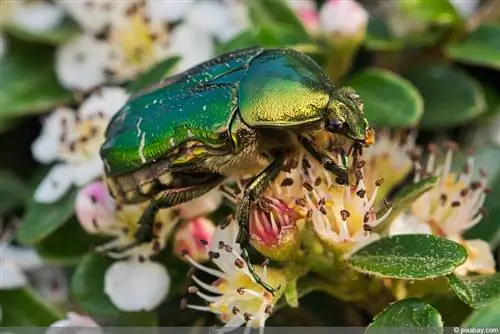
Who doesn't love the shiny green rose beetles (Cetonia aurata) in the garden? Even if you discover its larvae while digging up the compost, you don't need to worry about any harm. The rose beetle larvae are useful! They eat plant residues in the compost and improve the soil quality.
Characteristics of the rose beetle larvae
- short breastbones and two long pairs of legs
- C-shaped, belly-curving body
- white-gray body, brown hair
- 4 to 5 centimeters long
- Occurrence: in compost heaps
- Development period of the larvae: 2 to 3 years
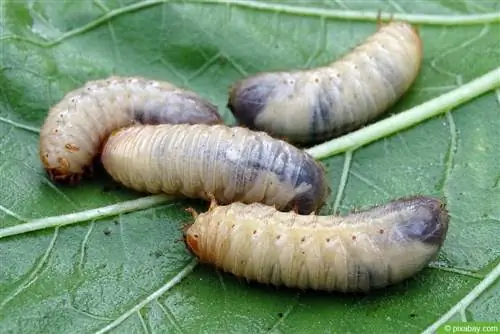
Tip:
If rose beetle larvae appear in pots or flower boxes, collect them and add them to the compost.
May beetle grub
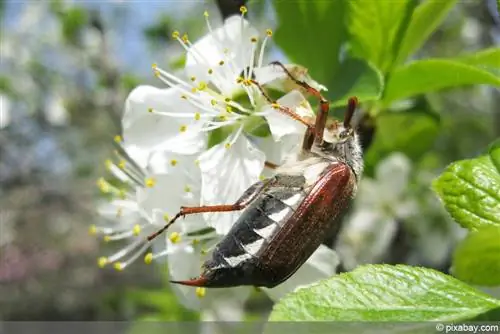
There are songs, poems and stories about the cockchafer (Melolontha). Do you also know Wilhelm Busch's story about Max and Moritz, who put some cockchafers in Uncle Fritz's bed? For hobby gardeners, May beetles and especially their larvae do not mean anything good. May beetle grubs cause a lot of damage in the garden. After hatching, they remain in the ground for between two and four years. Cockchafer grubs eat roots of ornamental and useful plants, even trees. Entire lawns are destroyed by the voracious animals. By the time the damage is noticed, it is often too late.
Characteristics of the cockchafer larvae
- significantly angled breastbones and two long pairs of legs
- C-shaped, belly-curving body
- white body, brown head capsule
- 4 to 6 centimeters long
- Occurs in beds and under lawns, never in compost
- Development period of the larvae: 2 to 4 years
June beetle grub
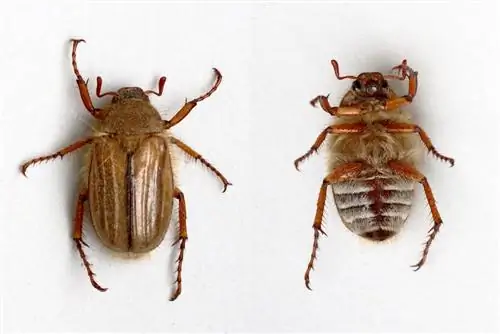
The June beetle (Amphimallon solstitiale) is similar to the May beetle, but is only half as big at 1.5 centimeters. Its larvae are just as feared as those of the cockchafer.
Characteristics of June beetle larvae:
- significantly angled breastbones and two long pairs of legs
- C-shaped, belly-curving body
- white body, brown head capsule
- 2 to 5 centimeters long
- Occurs mainly under lawns, never in compost
- Development period of the larvae: 2 to 3 years
Garden leaf beetle grub
The garden leaf beetle (Phylloperta horticola) is one of the smallest representatives of the scarab beetles. It only reaches a length of 8 to 15 millimeters. Garden leaf beetle larvae occur in large numbers and are considered the most important pests of lawns.
Characteristics of the garden chafer larvae:
- significantly angled breastbones and two long pairs of legs
- C-shaped, belly-curving body
- white body, brown head capsule
- conspicuous bristles on the abdomen
- 1 to 3 centimeters long
- Occurs mainly under lawns, prefers dry areas
- Development period of the larvae: 2 to 3 years
Spot the difference
A simple trick helps to distinguish the useful grubs of the rose and rhinoceros beetles from the harmful May, June and garden leaf beetle larvae. Place the larva on a smooth surface. May and June beetle larvae initially remain curved on the surface. June beetle larvae then try to move forward on their stomachs, May beetle larvae lie on their sides. Rose beetles stretch and move forward while lying on their backs with their little legs stretched upwards.
Rhinoceros beetle larvae can be easily recognized by their size. Rose and rhinoceros beetles differ from the harmful grubs because of their thickened rear parts.
The simplest distinguishing feature is the place of occurrence. The grubs of the May, June and garden beetles are never found in compost.
Combat
Nematodes
Unfortunately, the destruction of the roots has often already progressed significantly by the time the beetle larvae are spotted in the lawn or raised bed. The use of chemical pesticides has not proven effective as further impairment of the he alth of plants and animals in your garden cannot be ruled out.
We recommend nematodes of the genus Heterorhabditis bacteriophora to effectively combat beetle larvae. Nematodes penetrate the larvae through the body openings in order to reproduce within them. The grubs of May, June and garden beetles are killed within a few days.
Collect
If you discover grubs in the lawn or raised bed, collect them and destroy them. Especially after heavy rain, the beetle larvae come to the surface and can be picked up. Scarify the lawn and collect as many larvae as you can find.
Setting up traps
A grub trap is built quickly. Fill a bucket with compost or horse manure. Dig it about 50 centimeters into the ground and mark this spot. The grubs will enjoy the food and you can dig up the bucket full of grubs next year.
Chickens
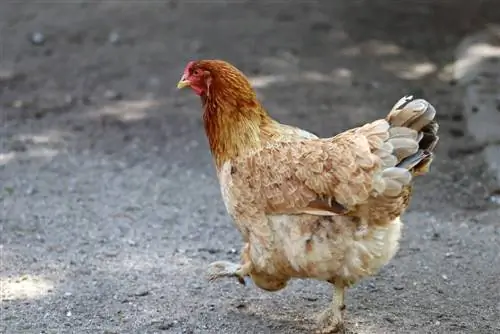
Do chickens live in your neighborhood? Borrow three or four chickens if you spot grubs after digging or after a rain. After the animal work, the beetle larvae are gone and the chickens are full and happy.
Insecticides
Various pest control products are available commercially. These often have negative effects on the beneficial insects in your garden. Therefore, first try to control the grubs using gentle, biological means.
Prevention
With appropriate measures you can prevent grub infestation in the lawn or raised bed:
- Avoid lighting in the garden at night. The beetles are attracted to the bright light and encouraged to lay their eggs.
- If you notice leaf beetles, May beetles or June beetles in the garden, collect them quickly and thoroughly.
- Scarify your lawn regularly. Scarifying brings the pests to the surface and attracts natural predators. Moles, bats and birds enjoy eating the thick beetle larvae.
- Put insect protection nets over your beds from May to June if you spot beetles in your garden. This protects them from the beetles laying their eggs.
- Keep your beds and lawn free of weeds. The more carefully you care for your garden, the less likely the pests will be.
- Create a habitat for beneficial insects and small animals. Hedgehogs, bats and birds quickly kill the beetles.
- Some plants have a deterrent effect on grubs, for example garlic, geraniums and delphiniums. Plant these for prevention.

